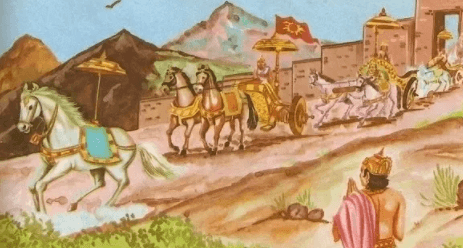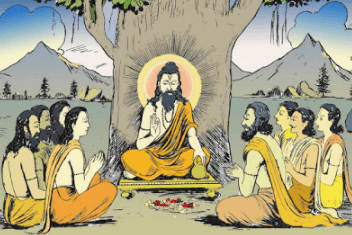Culture: The Vedic Period - Delhi Police Constable PDF Download
Important Rituals
Rajasuya: The king’s influence was strengthened by rituals. He performed this sacrifice, which was supposed to confer supreme power on him.
Asvamedha: A king performed the Asvamedha, which meant unquestioned control over an area in which the royal horse ran uninterrupted.

Asvamedha ritual
Vajapeya: A king performed the Vajapeya or the chariot race, in which the royal chariot was made to win the race against his kinsmen.
Chief Priests
The four chief priests who were engaged in performing the Shrauta sacrifiices were called Hotri, the invoker, Adhvaryu, the executor of the sacrifice, Udgatri, the singer, and Brahman, the high priest.
- Hotri: They recited Rig Samhita.
- Udgatri: They chanted the songs of Sama Samhita at the Soma sacrifice.
- Adhvaryu: Formulae of Yajur Samhita were to be uttered by the Adhvaryu priests who performed the manual work involved in a sacrifice.
Types of Marriage
(i) Brahma: Marriage of a duly dowered girl to a man of the same class.
(ii) Daiva: In this type of marriage, the father gives a daughter to a sacrificial priest as part of his fee.
(iii) Arsa: In this type of marriage, a token bride-price of a cow and a bull is given in place of the dowry.
(iv) Prajapatya: The father gives the girl without dowry and without demanding the bride-price.
(v) Gandharva: Marriage by the consent of the two parties, which might be solemnized merely by plighting troth.
(vi) Asrua: Asura marriage, in which the bride was bought from her father, was looked upon with disfavour by all the sacred texts, though the Arishashastra allows it without criticism.
(vii) Rakshasa: Rakshasamarriage, or marriage by capture, was practised especially by warriors.
(viii) Paishacha: It was the seduction of girl while asleep, mentally deranged or drunk Of these eight forms the first four were generally approved and were permissible to brahmans. The other forms were looked on with varying degrees of disfavours by the pious. Gandharva marriage, which often might amount to no more than a liaison, was surprisingly respected. A special form of the gandharva marriage was the Swaymvar or “self-choice”.
Philosophical Systems
A large number of school of thought was prevalent in ancient times, but we know nine of them as the most important and influential. 
They are the Charvaka, Jaina, Buddha, Vaisheshika, Nyaya, Sankhya, Yoga, Mimansa and Vedanta. They fall into two groups, Astika and Nastika, the former believing in the authority of the Vedas and the latter discarding it. The first three systems are Nastika and all others are Astika. Jaina and Buddha schools of philosophy will be dealt with separately.
Charvaka System: The Charvaka system, also called Lokayata Darshna (the philosophy of the masses) propounds gross materialism.
Among the orthodox systems of philosophy (Astika) there is some similarity and affinity between Nyaya and Vaisheshika, between Sankhya and Yoga, and between Mimansa and Vedanta. In the first two systems there is an affinity of philosophical doctrines, in the last two affinity is limited to the foundations and procedures, both systems having Vedic texts (one earliers and the other later) as their source, and the method of interpretation of the texts as the process of thinking. The Mimansakas recognize the Vedas as the final authority in determining the duties of man, and the Vedantists in gaining true knowledge about man and the universe. One is concerned with Karma-Kanda and the other with the Jnana-kanda of the Vedas, that is, the Samhitas and the Brahmanas, and the Upanishads respectively. This “Six systems of Hindu Philosophy” is also know as Shad-darshana.
(i) Vaisheshika (Particular Characteristics) : Propounded by Uluka Kanada. It is a realistic, analytic, and objective philosophy of the world.
(ii) Nyaya (Analysis): Propounded by Akshapad Gautama. It accepts all the categories recognized by the Vaisheshika system and adds one Abhava (negation).
(iii) Sankhya (Enumeration): Its legendary founder was Kapila. It is perhaps the oldest of the six systems, being mentioned in the Bhagavad Gita and occurring in a primitive form in the Upanishada. It is dualistic in its ontology. It believes in two ultimate realities Prakriti and Purusha.
(iv) Yoga (Application): Propounded by Patanjali. It is more or less applied Sankhya. It was based on the control of the body physically and implied that a perfect control over the body and the senses led to knowledge of the ultimate reality.
(v) Mimmnsa or Purva Mimamsa (Inquiry): Propounded by Jaimini. It is a philosophy of interpretation, application and use of texts of the Samhita and Brahamana portions of the Vedas.
(vi) Vedanta (End of the Vedas): It is also called Uttara Mimansa. The basic text of the system is the Brahma Sutras of Badarayana. Vedanta was decisive in refuting the theories of non-brahmanical schools.
FAQs on Culture: The Vedic Period - Delhi Police Constable
| 1. What is the Vedic Period? |  |
| 2. What are the Vedas and what do they contain? |  |
| 3. Who were the main gods worshipped during the Vedic Period? |  |
| 4. What were the social and political structures during the Vedic Period? |  |
| 5. What were some of the major developments during the Vedic Period? |  |















